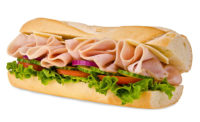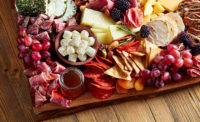For the past several years, traditional supermarkets have turned to using their strengths, which includes their in-store bakeries, delis and prepared food items. In turn, they are offering viable options for consumers seeking breakfast and lunch sandwiches.
“People are looking for more convenient options, and they’re looking beyond the traditional fast food and QSR channels,” explains Eric Richard, industry relations coordinator for the International Dairy Deli Bakery Association, Madison, Wis. “This is where we see traditional retail take more of a proactive role in connecting with consumers.”
Brian Hofmeier, Harrison, Ohio-based JTM Food Group’s vice president of education and sales, agrees that retailers’ delis can now act like a restaurant. For example, retailers now offer fresh-made sandwiches that consumers can pair with a salad or soup.
“Many times they like the ‘my way,’ concept meaning ‘I get to watch it made in front of me’ or ‘they are making it exactly the way that I want it,’” Hofmeier says. “A lot of retailers have begun to emulate Chipotle, Subway, Jimmy John’s and that concept idea, so you see all the ingredients.”
Even if the sandwich has already been prepared, consumers are still able to see where the product was made, he says.
In turn, speed, or the ability of which to serve a large quantity of people in a specified short period of time, becomes one of the greatest challenges of making fresh sandwiches. Advancements, such as speed ovens, sous-vide techniques and panini presses, have helped to heat things up quickly, Hofmeier says.
While sandwiches are competing against bowls and burritos, which are popular with Millennials, offering smaller sandwiches is one way to stay relevant to younger consumers.
“Gen Y and Gen Z has to only eat with one hand, because the other hand has a phone in it,” Hofmeier says. “If what you are giving them requires them to use both hands, it is not going to be popular.”
From a labeling standpoint, whether the ingredient is on a packaging label or menu, it must be clean and understandable. “Gen Y, Gen Z and the Millennials read labels, and they ask ‘What is it?’” Hofmeier says.
Packaged Sandwiches
The move toward clean-label ingredients, including eliminating partially hydrogenated oils, soy, artificial colors and flavors, and switching to all natural antioxidants, also is one of the biggest trends affecting on-the-go packaged breakfast sandwiches, says Roger Williams, owner of Williams Sausage Co., Union City, Tenn.
In addition to consumers’ clean-label demands, breakfast sandwiches are becoming more complex due to the changing tastes of consumers and wanting more varieties, he says. Williams believes healthier sandwiches with a greater variety of components will continue to grow in the sandwich category moving forward.
One of the greatest challenges in breakfast sandwich construction is the on-going labor shortage coupled with high-volume demand, Williams says. From slicing bread to stacking multiple components, several people are required to construct sandwiches. “Making sandwiches is very labor intensive, and we are finding it difficult to stay fully staffed,” he says.
Due to the labor shortage, Williams Sausage is exploring using robots to help construct sandwiches, and hopes to have a robotic line running by the third quarter of 2020. “Robotic systems have advanced in the last few years to the point that we think certain aspects of sandwich assembly can be automated,” Williams says. IP






Report Abusive Comment